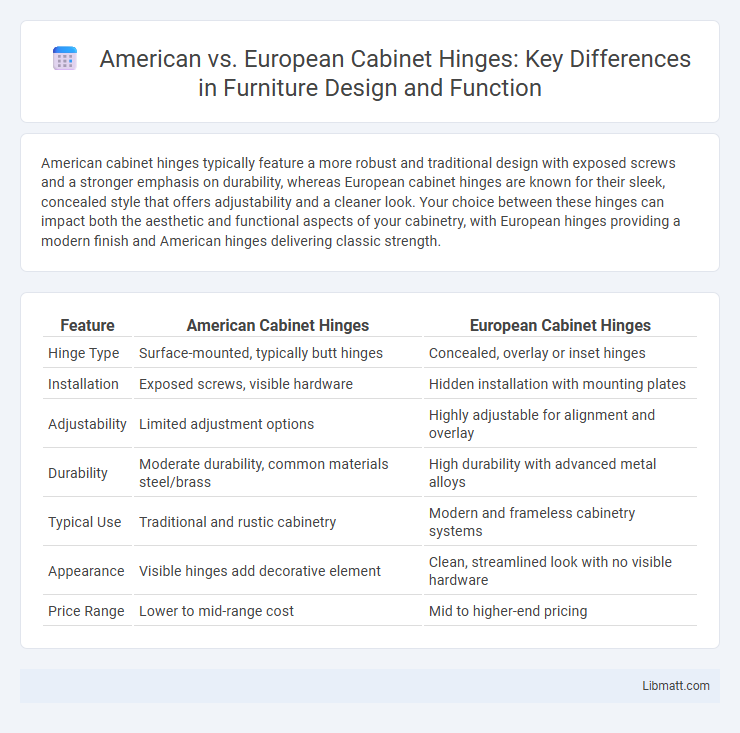American cabinet hinges typically feature a more robust and traditional design with exposed screws and a stronger emphasis on durability, whereas European cabinet hinges are known for their sleek, concealed style that offers adjustability and a cleaner look. Your choice between these hinges can impact both the aesthetic and functional aspects of your cabinetry, with European hinges providing a modern finish and American hinges delivering classic strength.
Table of Comparison
| Feature | American Cabinet Hinges | European Cabinet Hinges |
|---|---|---|
| Hinge Type | Surface-mounted, typically butt hinges | Concealed, overlay or inset hinges |
| Installation | Exposed screws, visible hardware | Hidden installation with mounting plates |
| Adjustability | Limited adjustment options | Highly adjustable for alignment and overlay |
| Durability | Moderate durability, common materials steel/brass | High durability with advanced metal alloys |
| Typical Use | Traditional and rustic cabinetry | Modern and frameless cabinetry systems |
| Appearance | Visible hinges add decorative element | Clean, streamlined look with no visible hardware |
| Price Range | Lower to mid-range cost | Mid to higher-end pricing |
Introduction to Cabinet Hinges: American vs European
American cabinet hinges typically feature exposed designs, such as butt hinges and surface-mounted types, offering classic aesthetics and straightforward installation. European cabinet hinges, also known as concealed or cup hinges, are recessed into the door, providing a sleek, modern look with adjustable settings for precise door alignment. The choice between American and European hinges affects both the visual appeal and functionality of cabinetry, influencing durability, ease of installation, and maintenance.
Key Differences Between American and European Hinges
American cabinet hinges typically feature exposed parts and are known for their traditional design, often using butt or overlay hinges that are visible when the door is closed. European hinges, also called concealed or cup hinges, offer a sleek, hidden look with adjustable features that allow for precise door alignment and are mounted inside the cabinet frame. Your choice depends on aesthetic preferences and installation needs, with European hinges favored for modern cabinetry due to their clean appearance and flexibility.
Types of American Cabinet Hinges
American cabinet hinges commonly include types such as overlay, inset, and full wrap hinges, each designed to accommodate various door styles and installation preferences. Overlay hinges mount on the cabinet frame, allowing doors to cover the cabinet edge, while inset hinges fit inside the cabinet frame for a flush appearance. Selecting the right hinge type influences the function and aesthetic, ensuring your cabinetry operates smoothly and suits your design needs.
Types of European Cabinet Hinges
European cabinet hinges primarily include concealed hinges such as the full overlay, half overlay, and inset types, each designed to accommodate different door and frame configurations. Soft-close options enhance functionality by preventing slamming and extending the life of your cabinets. These hinges offer superior adjustability compared to traditional American-style hinges, allowing precise alignment and a sleek, modern finish for your cabinetry.
Installation Methods: American vs European Hinges
American cabinet hinges typically require surface mounting with visible screws, making installation straightforward but less concealed. European hinges use a concealed mounting system with a cup drilled into the door and mounting plates fixed inside the cabinet, offering a cleaner, seamless look. The European method allows for easier adjustments post-installation, enhancing precision and alignment.
Aesthetic Considerations in Hinge Selection
American cabinet hinges often feature more visible hardware with decorative finishes that complement traditional and rustic kitchen designs, while European hinges are concealed, providing a sleek, modern aesthetic favored in minimalist and contemporary cabinetry. The choice between these hinge types significantly impacts the cabinetry's overall look, influencing whether the hardware becomes a design focal point or remains hidden to maintain clean lines. Selecting hinges with finishes that harmonize with cabinet colors and styles enhances visual appeal and supports the desired aesthetic theme in kitchen design.
Durability and Performance Comparison
American cabinet hinges typically feature robust construction with thicker metal components that enhance durability under heavy use, making them ideal for kitchens with frequent access. European hinges usually offer smoother, concealed designs with advanced soft-closing mechanisms that improve performance and reduce wear over time. Your choice depends on whether you prioritize long-lasting strength or seamless operation, as each hinge type excels in different functional aspects.
Cost Analysis: American vs European Hinges
European cabinet hinges generally cost more upfront than American hinges due to their advanced engineering and concealed design features. American hinges, often surface-mounted and simpler, provide a budget-friendly option with lower initial expenses but may require more maintenance over time. Long-term cost analysis favors European hinges for durability and aesthetic value, potentially reducing replacement and repair costs despite higher initial investment.
Popular Use Cases and Applications
American cabinet hinges are widely used in traditional kitchen cabinetry and furniture, offering durability and smooth operation suitable for residential settings. European cabinet hinges, known for their hidden design and adjustable features, are popular in modern kitchens, office furniture, and custom cabinetry, providing a sleek aesthetic and precise alignment. Both hinge types accommodate various door thicknesses, but European hinges excel in frameless cabinet construction and soft-closing mechanisms.
How to Choose the Right Cabinet Hinge for Your Project
Selecting the right cabinet hinge involves understanding the key differences between American and European styles, such as overlay options, opening angles, and installation methods. American hinges typically offer a simpler design with visible hardware, while European hinges provide a sleek, concealed look with adjustable functionality. Consider your cabinet design, desired aesthetic, and ease of adjustment to ensure your project benefits from the ideal hinge performance.
American vs European Cabinet Hinges Infographic

 libmatt.com
libmatt.com